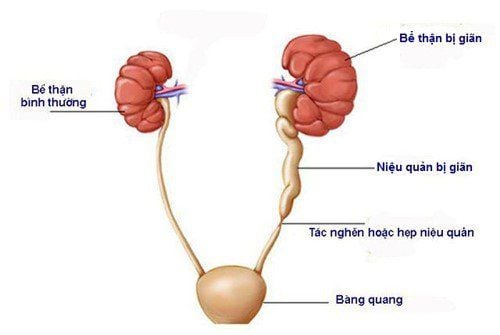This is an automatically translated article.
The article is expertly consulted by Master, Doctor Le Phuc Lien - Urologist - Department of General Surgery - Vinmec Central Park International General Hospital. The doctor has more than 12 years of experience in the field of urology and specialized urology.Ureteral stones are mostly caused by kidney stones moving down, this is one of the dangerous urolithiasis, too complicated to move, difficult to treat. Depending on the size, shape, and number of ureteral stones, there are different levels of danger.
1. How are ureteral stones formed?
The process of forming ureteral stones can be divided into stages:1.1 Early stage At this time, the stones have just arisen and moved, not causing obstruction of the urinary tract. When newly formed, stones do not cause symptoms or are present but still faint, this stage usually lasts for 2 years. If ureteral stones are detected early at this time, they can be easily treated by using drugs to help erode and push the stones out.
Usually, when the stone is more than 4mm in size in the ureter, it will cause acute obstruction of the ureter. The change of blood flow to the kidney, the pressure inside the ureter develops in 3 stages.
First stage: The pressure inside the ureter and blood flow to the kidney both increase, causing the arterioles to dilate. Blood flow to the kidneys is still maintained, but less than normal. Stage two: Blood flow to the kidney decreases, but the pressure in the ureter continues to increase, causing arterioles to constrict, which later leads to obstruction. Stage three: Blood flow to the kidneys continues to decrease, and pressure in the ureters begins to decrease as well. At this time, both the afferent arterioles and the efferent arterioles constrict, and the glomerular filtration rate also decreases. At this stage, ureteral stones cause renal colic, pain in the waist, hips, pain can spread to the abdomen, thighs, in some cases fever.

Sỏi niệu quản kích thước lớn sẽ gây tắc niệu quản
1.2 Intervention stage At this point, the stone has been blocked to move no more and there are symptoms, some complications appear such as dilated renal calyces. Ureteral stones have not caused serious complications, kidney function can be restored after stone removal.
The patient presents with obvious symptoms such as pain and hematuria due to stone obstruction causing urinary retention and other minor complications. If detected and treated at this stage, minimally traumatic interventions can be applied.
1.3 Late stage Stones at this time have caused serious complications such as infection, pyelonephritis, fluid retention, loss of kidney function, nephritis, atrophic pyelonephritis.
When the kidneys are waterlogged, a long-term infection will gradually destroy the kidney tissue, the kidney unit, causing kidney failure in the long run. At this time, to be able to maintain life, the patient needs dialysis or a very expensive kidney transplant, which cannot be cured.
2. The level of danger when ureteral stones form and grow
Each stage of ureteral stones has its own characteristics, the patient needs to have an appropriate attitude to manage to bring about good treatment results. Treatment of ureteral stones is aimed at 2 purposes: eliminating stones from the urinary tract and complications, re-establishing the patency of the urinary tract, and preventing recurrence of stones.Depending on the size, shape and surface characteristics of the stone, the degree of danger of ureteral stones to the kidneys and urinary tract will be different. Some complications that can occur when stones move in the ureters include:
Inflammation, infection of the ureters Stones move in the ureters causing damage to the lining of the ureters, creating conditions for bacteria to grow and cause inflammation.
Water retention in the kidneys, ureters Stones located in the ureters cause blockage of the water passage, resulting in water stagnation at the upper position of the stone.
Acute and chronic pyelonephritis The prolonged inflammation of the ureters, severe inflammation and water retention give bacteria the opportunity to move upstream, causing acute pyelonephritis. Repeated acute pyelonephritis leads to chronic inflammation, fibrosis of renal interstitial organization.
Renal dilatation Stagnant water causes dilatation of the calyx, renal pelvis, and ureter of the upper part of the stone. Renal dilation increases the secretion of Prostaglandin A2 - a substance that causes severe renal vasoconstriction.
Acute kidney failure Occurs when a stone completely blocks the urinary tract on both sides of the ureter.
Chronic kidney failure Chronic kidney failure is the most serious complication that ureteral stones cause, kidney cells have been irreversibly fibrosis.

Phát hiện và điều trị sớm sỏi niệu quản là tốt nhất
At present, ureteral stones can be effectively treated by modern methods, in which, ureteroscopy with laser lithotripsy or by air pulse are two highly appreciated methods. Ureteroscopy for lithotripsy with laser or pulse is being treated at Vinmec hospital system by experienced urologists.
The hospital uses the Sphinx30 Laser lithotripsy machine, which is the most modern and best laser machine in Vietnam today to help doctors successfully perform difficult cases of ureteral stones. The outstanding advantage of Laser Sphinx30 is that it can stop bleeding well and cause necrosis at the lowest level of surrounding cells.
Customers who are interested in the treatment of ureteral stones as well as ureteroscopy with laser lithotripsy and pulse gas treatment for ureteral stones can go directly to the nationwide Vinmec hospital system for examination.
Please dial HOTLINE for more information or register for an appointment HERE. Download MyVinmec app to make appointments faster and to manage your bookings easily.













